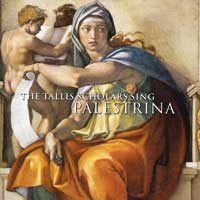Palestrina is the composer The Tallis Scholars have sung and recorded most frequently and this two discs set contains some of the best, in their view, recordings from the very first record they made commercially (in 1980), to one of the most recent. In general they have concentrated on his Mass settings not least because they make such effective concert music. Palestrina had an unusual ability to write positive, outward-going, major-key music which, over the length of a Mass-setting, is a great strength: penitential writing tends to be more effective in shorter bursts. Three of the four settings in this collection rely on bright sonorities; the fourth - Sicut lilium - is more subdued and sensuous, as the words of the motet require. The Missa Assumpta est Maria, based on his own motet of that name which in turn is based on a short phrase of chant, is a classic example of sonorous Palestrina, its excitement achieved in large part by doubling the sopranos and tenors. The brighter sound this high-scored six-voice (SSATTB) choir produces is then emphasized in the style of the writing, which is more chordal than usual. The parody motet Assumpta est Maria shows the way in its opening bars: the three upper voices are grouped against the three lower ones in easily audible antiphony. This late-Renaissance method is then transferred to the Mass, most obviously in the Gloria and Credo but also in the first Kyrie, where greater elaboration was more customary. The sheer verve of this music has ensured that, along with Papae Marcelli, Assumpta est Maria has remained the most performed of all Palestrina's 107 Mass-settings. The second disc opens with a six-voice (SSATTB) set of Lamentations, originally the third lesson on the Saturday of Holy Week. The Missa Brevis (for four voices SATB), although relatively 'short' and straightforward in musical style, shows Palestrina's idiom at its most accessible. |


